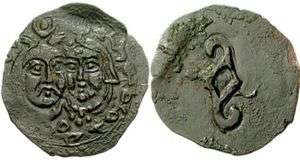Principality of Chaghaniyan
The Principality of Chaghaniyan, known in Arabic sources as al-Saghaniyan, was a local Iranian dynasty, which ruled the Chaghaniyan region from the early 7th-century to the late 8th-century. The rulers of the region were known by their titles of “Chaghan Khudah” (Middle Iranian; Čagīnīgān Xvaday, meaning “the lord of Chaghaniyan”).[a]
History

During the early 7th-century, Chaghaniyan became independent from Hephthalite rule, and came under the control of local rulers known as the “Chaghan Khudah”.[1] During the Muslim conquest of Persia, the Chaghan Khudah aided their kinsmen, the Sasanians, during their struggle against the Rashidun Arabs. However, the Arabs, after having dealt with the Sasanian Empire, began focusing on the local rulers of Khorasan, which included the Chaghan Khudah and many other local rulers. In 652, the Chaghan Khudah, along with the rulers of Talaqan, Guzgan, and Faryab, aided the ruler of southern Tokharistan against the Arabs. Nevertheless the Arabs managed to emerge victorious during the battle. However, the Rashidun Caliphate soon fell into civil war, and was conquered by another Arab family, who founded the Umayyad Caliphate. During the early 660s, the Chaghan Khudah, known as Turantash, sent an envoy under his chancellor Pukarzate to Varkhuman, the Sogdian king of Samarkand.[2]
In 705, the Arab general Qutayba ibn Muslim managed to make the Chaghan Khudah, whose name is mentioned as Tish, acknowledge Umayyad authority. The real reason for Tish's submission, however, was to gain aid in defeating the local rulers of Akharun and Shuman in northern Tokharistan, who had been making incursions against him.[1][3] Qutayba shortly defeated the two rulers, and forced them to acknowledge Umayyad authority.
However, in 718, Tish, along with Gurak, the king of Samarkand, Narayana, the king of Kumadh, and Tughshada, the Bukhar Khudah of Bukhara, sent an embassy to the Tang dynasty of China, where they asked for aid against the Arabs.[4] Nevertheless, the principality of Chaghaniyan still aided the Arabs against the Turgesh, and were present at the side of the Arabs during the Battle of the Baggage, where they were defeated and the Chaghan Khudah was killed. After the battle, most of Khorasan except Chaghaniyan remained under Arab control. Under Nasr ibn Sayyar, Chaghaniyan was once again a vassal of the Umayyad Caliphate. After this, the Chaghan Khudahs begin to fade from the sources. In the late 8th-century Chaghaniyan fell under the direct control of the Abbasid Caliphate, which had succeeded the Umayyad Caliphate in 750. The Muhtajids, an Iranian dynasty which in the 10th-century gained control over Chaghaniyan, may have been descended from the Chaghan Khudahs.[5]
Notes
^ a: Also spelled Chaghan Khuda, Chaghan Khoda, and Saghan Khuda,
References
- Bosworth 1990, pp. 614–615.
- Hansen 2012, p. 127.
- Gibb 1923, p. 32.
- Gibb 1923, p. 60.
- Bosworth 1984, pp. 764-766.
Sources
- Bosworth, C. E. (1986). "Ḳutayba b. Muslim". In Bosworth, C. E.; van Donzel, E.; Lewis, B. & Pellat, Ch. (eds.). The Encyclopaedia of Islam, New Edition, Volume V: Khe–Mahi. Leiden: E. J. Brill. pp. 541–542. ISBN 90-04-07819-3.
- Gibb, H. A. R. (1923). The Arab Conquests in Central Asia. London: The Royal Asiatic Society. OCLC 499987512.
- Shaban, M. A. (1979). The 'Abbāsid Revolution. Cambridge: Cambridge University Press. ISBN 0-521-29534-3.
- Blankinship, Khalid Yahya, ed. (1989). The History of al-Ṭabarī, Volume XXV: The End of Expansion: The Caliphate of Hishām, A.D. 724–738/A.H. 105–120. SUNY Series in Near Eastern Studies. Albany, New York: State University of New York Press. ISBN 978-0-88706-569-9.
- Blankinship, Khalid Yahya (1994). The End of the Jihâd State: The Reign of Hishām ibn ʻAbd al-Malik and the Collapse of the Umayyads. Albany, New York: State University of New York Press. ISBN 978-0-7914-1827-7.
- B. A. Litvinsky, Ahmad Hasan Dani (1996). History of Civilizations of Central Asia: The crossroads of civilizations, A.D. 250 to 750. UNESCO. pp. 1–569. ISBN 9789231032110.CS1 maint: ref=harv (link)
- Wellhausen, Julius (1927). The Arab Kingdom and Its Fall. University of Calcutta.
- Bosworth, C. Edmund (1990). "ČAḠĀNĪĀN". Encyclopaedia Iranica, Vol. IV, Fasc. 6. London et al.: C. Edmund Bosworth. pp. 614–615.CS1 maint: ref=harv (link)
- Bosworth, C. Edmund (1984). "ĀL-E MOḤTĀJ". Encyclopaedia Iranica, Vol. I, Fasc. 7. London et al.: C. Edmund Bosworth. pp. 764–766.CS1 maint: ref=harv (link)
- Hansen, Valerie (2012). The Silk Road. Oxford University Press. pp. 1–304. ISBN 9780195159318.
Diwashini.
CS1 maint: ref=harv (link)